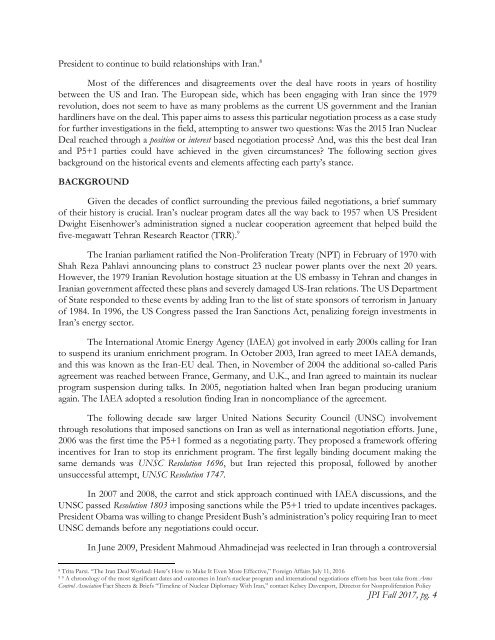Fall 2017 JPI
You also want an ePaper? Increase the reach of your titles
YUMPU automatically turns print PDFs into web optimized ePapers that Google loves.
President to continue to build relationships with Iran. 8<br />
Most of the differences and disagreements over the deal have roots in years of hostility<br />
between the US and Iran. The European side, which has been engaging with Iran since the 1979<br />
revolution, does not seem to have as many problems as the current US government and the Iranian<br />
hardliners have on the deal. This paper aims to assess this particular negotiation process as a case study<br />
for further investigations in the field, attempting to answer two questions: Was the 2015 Iran Nuclear<br />
Deal reached through a position or interest based negotiation process? And, was this the best deal Iran<br />
and P5+1 parties could have achieved in the given circumstances? The following section gives<br />
background on the historical events and elements affecting each party’s stance.<br />
BACKGROUND<br />
Given the decades of conflict surrounding the previous failed negotiations, a brief summary<br />
of their history is crucial. Iran’s nuclear program dates all the way back to 1957 when US President<br />
Dwight Eisenhower’s administration signed a nuclear cooperation agreement that helped build the<br />
five-megawatt Tehran Research Reactor (TRR). 9<br />
The Iranian parliament ratified the Non-Proliferation Treaty (NPT) in February of 1970 with<br />
Shah Reza Pahlavi announcing plans to construct 23 nuclear power plants over the next 20 years.<br />
However, the 1979 Iranian Revolution hostage situation at the US embassy in Tehran and changes in<br />
Iranian government affected these plans and severely damaged US-Iran relations. The US Department<br />
of State responded to these events by adding Iran to the list of state sponsors of terrorism in January<br />
of 1984. In 1996, the US Congress passed the Iran Sanctions Act, penalizing foreign investments in<br />
Iran’s energy sector.<br />
The International Atomic Energy Agency (IAEA) got involved in early 2000s calling for Iran<br />
to suspend its uranium enrichment program. In October 2003, Iran agreed to meet IAEA demands,<br />
and this was known as the Iran-EU deal. Then, in November of 2004 the additional so-called Paris<br />
agreement was reached between France, Germany, and U.K., and Iran agreed to maintain its nuclear<br />
program suspension during talks. In 2005, negotiation halted when Iran began producing uranium<br />
again. The IAEA adopted a resolution finding Iran in noncompliance of the agreement.<br />
The following decade saw larger United Nations Security Council (UNSC) involvement<br />
through resolutions that imposed sanctions on Iran as well as international negotiation efforts. June,<br />
2006 was the first time the P5+1 formed as a negotiating party. They proposed a framework offering<br />
incentives for Iran to stop its enrichment program. The first legally binding document making the<br />
same demands was UNSC Resolution 1696, but Iran rejected this proposal, followed by another<br />
unsuccessful attempt, UNSC Resolution 1747.<br />
In 2007 and 2008, the carrot and stick approach continued with IAEA discussions, and the<br />
UNSC passed Resolution 1803 imposing sanctions while the P5+1 tried to update incentives packages.<br />
President Obama was willing to change President Bush’s administration’s policy requiring Iran to meet<br />
UNSC demands before any negotiations could occur.<br />
In June 2009, President Mahmoud Ahmadinejad was reelected in Iran through a controversial<br />
8 Trita Parsi. “The Iran Deal Worked: Here’s How to Make It Even More Effective,” Foreign Affairs July 11, 2016<br />
9 9 A chronology of the most significant dates and outcomes in Iran’s nuclear program and international negotiations efforts has been take from Arms<br />
Control Association Fact Sheets & Briefs “Timeline of Nuclear Diplomacy With Iran,” contact Kelsey Davenport, Director for Nonproliferation Policy<br />
<strong>JPI</strong> <strong>Fall</strong> <strong>2017</strong>, pg. 4
















